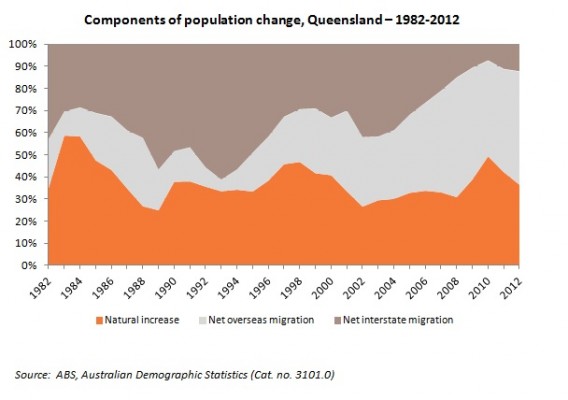Well think again. In my myth busting way, here’s some things you may or may not know about Queensland’s population.

Population growth and change
- Queensland has consistently grown faster and by larger amounts over the last 30 or so years than other states and territories. Since 1981, Queensland has grown by 2.2 million people, compared to 2.1 million in NSW. There are two distinct periods when Queensland has grown particularly fast – the first half of the 1990s, when it seemed that most of Victoria was heading north, and in the first half of the 2000s. Since 2006, Western Australia has grown faster than Queensland – thanks largely to the mining boom.
- In the 2000s, Queensland added 825,679 people to its population, about 30% of Australia’s total population growth. In the same period, Victoria grew by 705,499 and NSW by 621,407 – this despite the pull of Sydney and Melbourne as gateways for overseas migrants.
- Traditionally, Queensland’s population has grown on the back of interstate migration (especially from NSW and Victoria) and natural increase (births minus deaths). Net overseas migration has been less important – until recently. Since 2008 around half of Queensland’s population growth is attributable to net overseas migration – largely at the expense of net interstate migration – which only comprised about 12% of growth in 2012 – compared to over half in the early 1990s. While some of this change is due to the changing definition of “net overseas migration” which the ABS introduced after 2006, there is no doubt that the mining boom is having an impact, and that Brisbane is becoming more connected to the global economy in a similar manner to Sydney and Melbourne.

The role of interstate migration
- and speaking of interstate migration – where does Queensland gain population from? The contribution of various states and territories to Queensland net interstate migration gain has changed over the years, but one constant is NSW – it has always lost population to Queensland, but the losses have declined over the last decade. The big change has been Victoria – despite the perception that hordes of “Mexicans” move north, the peak years for net gain from the southern state coincided with the early 1990s recession and the so-called “Kennett effect”. In 1993 the net interstate gain to Queensland from Victoria was almost 40,000 – just pipping NSW. However since then the gain has trended down, and in the last few years has been below 3,000 per annum. This is related to long term economic shifts in the Victorian economy and increasing affluence which anecdotally may be influencing holiday home ownership in coastal areas rather than a permanent move north.
- the other big change is westward – Western Australia has grown rapidly in recent years and a quick look at interstate migration trends seems to suggest that people are heading west rather than north. This is surprising given that there are mining hot spots in Queensland. Since 2008 Queensland has generally recorded a net loss of people to Western Australia, a reversal of the pattern established in the previous decade. In 2011 and 2012 the net interstate loss to WA was in excess of 4,000 per annum. Queensland may be experiencing a mining boom of sorts, but is it attracting people from other parts of Australia? Or are Queenslanders moving west for non-mining related reasons? Whatever the case, the mining boom in Queensland doesn’t seem to be translating to net interstate migration gains in the same way as WA.
Moving away from the “bronzed Aussie” image
- it’s commonly said that about 10% of New Zealand’s population lives in Australia, and a common perception is that they gravitate to Sydney, particularly Bondi Beach. But did you know 40% of New Zealanders living in Australia live on the Gold Coast? No wonder there’s numerous flights each week between the two locations. Is this the 21st century equivalent of sun-belt migration?
- Queensland is slowly becoming more culturally diverse. The United Kingdom and New Zealand are by far and away the most common overseas born countries, with South Africa a distant third, however there are more rapid increases in the Chinese and Indian born (in common with Australia wide trends).
- between 2001 and 2011, the population of non-English speakers grew three times faster than the population as a whole – Punjabi was the fastest growing language group over these 10 years, underscoring the growth in migration from India.
Patterns of growth and change vary considerably
- the map below (click for a larger version) shows the population growth rate for LGAs in Queensland over the period 2011-12. In a departure from past trends, the fastest growing LGAs are those which have large scale mining projects eg central Queensland and the Mt Isa/Cloncurry region, though South East Queensland continues to exhibit strong population growth.
- in 2011-12, the fastest growing LGAs in Queensland were Weipa, located on the Cape York Peninsula (5.1%), followed by Central Highlands (3.4%), and then Gladstone and Ipswich (both 3.0%). The expansion of mining operations (bauxite and coal) is the driver behind growth in all these regions except for Ipswich. That LGA is located within Brisbane’s economic and social catchment, with a number of greenfield development fronts that attract young families.
- about one-third of Queensland’s LGAs recorded population decline – many of these were small rural communities and volumes were not large. Some of the more notable areas to lose population in 2011-12 were Charter Towers (-0.1%) and Hinchinbrook (in northern Queensland) which declined by 0.5%.
- mainly due to their size, the Brisbane City Council (+19,921) and Gold Coast City Council (+10,629) recorded the largest volume of growth in 2011-12, and this translated to 1.9% and 2.1% respectively.

Does mining = population growth?
- There is certainly a very strong relationship – but as with all things demographic, there are a number of factors to consider. The workforce of many mining projects operate on a “fly in fly out” or “drive in drive out” basis, depending on accessibility but also accommodation factors (eg the ability of local housing markets to absorb rapid population growth). In addition, the peak workforce often coincides with the construction rather than operational phase of the mine. Another factor to consider is the high wages commanded by the mining workforce and the impact this has on the non-mining sector in terms of housing affordability eg can they afford to live in a mining town?
- For example, Weipa’s population growth rate of 5.1% is off a very small base of around 3,500 people. Over the period 2001-11 growth was running at an average of 4.8% per annum. Bauxite has been mined in the area for several decades, and investment in and expansion of mining operations will no doubt provide a critical driver for future population growth.
- Over the period 2001-2011, the number of people employed in the mining sector in Queensland almost tripled in size. But in Greater Brisbane the growth was even stronger, which may indicate either growth of a non-resident workforce ie workers living in Brisbane but working for example in Mount Isa; or it may indicate the growth of off site jobs such as project management and administration.
Are you from Queensland? What other population and social trends what you like us to write about? Drop us a line and let us know!
Access our online demographic resource centre for more information about Australia’s population. Subscribe to our newsletter or blog for more demographic analysis or visit our website for more information about .id the population experts.














